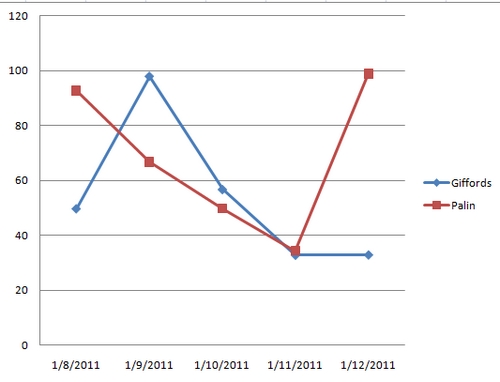
Tweeting Blood Libel -- A Visual Analysis
G. R. Boynton
On January 8 Representative Giffords was conducting her first "Congress on your corner" as the new session of Congress began when Jared Loughner fired a semi-automatic at Giffords and other people meeting with her. Six people were killed and 13 were wounded. Representative Giffords was shot in the head, was rushed to the hospital, and ten days later she seems to be on a long road to recovery. The immediate speculation was that this was the result of the vituperative language in the politics of Sarah Palin, Glenn Beck, and the teaparty more generally. Sarah Palin's symbol of cross hairs over Giffords' district, and "don't retreat, just reload" were favorite bits of evidence for this interpretation of events.
Four days passed. Representative Giffords was still in very serious danger. In the morning Sarah Palin released a video justifying her actions and accusing others. President Obama traveled to Arizona in the afternoon to address citizens of Arizona and the nation. But the 'big news' of the day was "blood libel," a phrase used by Sarah Palin to characterize the news medias' interpretation of how the shooting came to pass.
Twitter was very busy with people commenting and accusing. The figure gives the number of twitter messages that contained "Giffords" or "Palin" for each of the first five days.
 |
On the 8th, the day of the attack, and the 12th, the day of Palin's video, there were many more messages mentioning Palin than Giffords. The number of Twitter messages mentioning Giffords peaked at almost 100,000 on the 9th, and declined rapidly after that. Some critics suggested that Palin had been able to make the entire incident about herself -- for good or ill.
January 12 was the day of the "blood libel" reference, and it was used frequently enough that it became a trending topic on Twitter for a few hours. I want to analyze Twitter messages containing the words "blood libel" to see how people were responding to the phrase. The flow of messages follows one of the standard patterns [Boynton, 2010]. Tweets were coming very fast the first day and then the number declined each day after that until they were down to just over a thousand on the 15th. The figure shows the number of tweets per hour. I did not start collecting messages containing "blood libel" until several hours after the video was released. Computing by the hour gives the same base for each day.
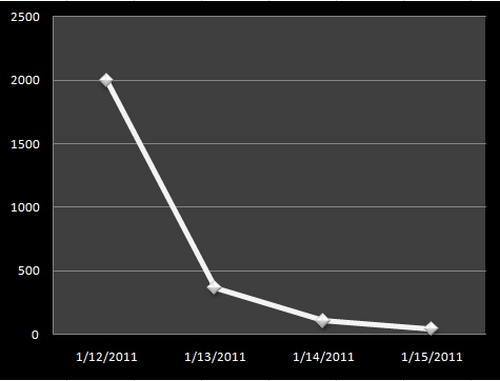 |
There were 1996 tweets per hour on the 12th, but the number dropped very quickly. By the 15th it was 43 per hour. Memory does not go away as quickly as the communication, but even something as explosive as this episode can fade quickly in the Twitter stream.
What did they say? To look at the messages I constructed word clouds of the words taken from 1,000 messages each day. The first day they were the messages from half an hour. On the 15th they were almost all of the messages of the day. For each day there is a word cloud containing all of the words in the messages. There is a second that leaves out "blood libel," since it must be in every message, and a couple of procedural markers. That left "Sarah Palin" as well as all of the other words. The third word cloud drops "Sarah Palin."
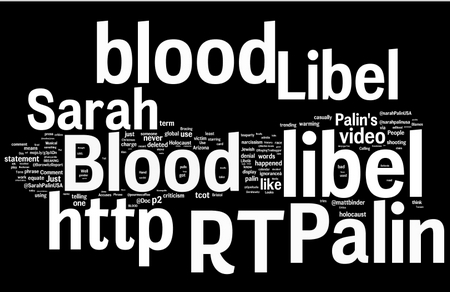 |
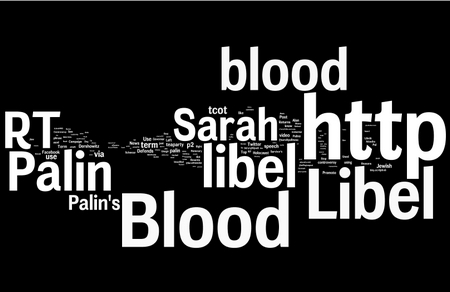 |
All Words on January 12 |
All Words on January 13 |
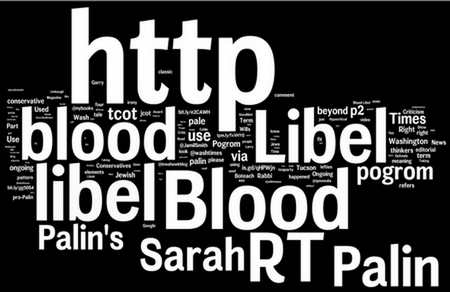 |
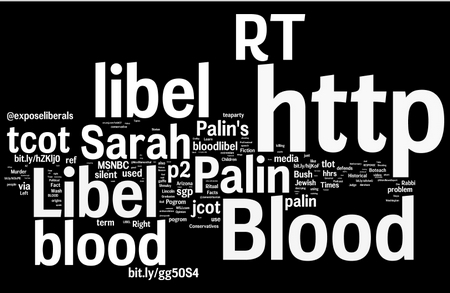 |
All Words on January 14 |
All Words on January 15 |
The size of the word is relative to the its frequency in the text. For more detail you can access a larger version of the image by clicking on it. Blood libel is present in each twitter message -- though in some it is capitalized and in some it is lower case. But blood libel stands out in each of the word clouds as does Sarah Palin. In addition, both RT and http stand out in all of the word clouds. http is the beginning of a url and means there was a reference to another document in the message. RT is roughly quotation with attribution. The message repeats a message that has already occurred. It is a mistake to understand messages on Twitter as independent of other communication streams. They are interacting with other streams and they are responding to each other. Those are the constants of presence. There is one constant that is about absence. "Giffords" does not show up on any of these word clouds. It was her blood that was shed, but the focus of attention shifted to Palin and teaparty politics.
There are, however, other word patterns that change over time. "Video" is only visible in the word cloud for the 12th. The 13th is unusual in the dominance of the words that appear in each word cloud. All other words are not visible. "Pogrom" shows up in the word cloud for the 14th. This was a repeated accusation that the opposition was engaged in a pogrom against Palin. And http becomes larger than in the first two word clouds as the messages began feverishly providing evidence of the pogrom. It is also the first time that tcot, top conservatives on twitter, is frequent enough to be seen. By this point messages defending Palin outnumber either general comments or comments critical of Palin. For the word cloud of the 15th tcot is again larger with more frequent occurrences though for a much smaller number of tweets; at that point it was down to 1,000+ for the day.
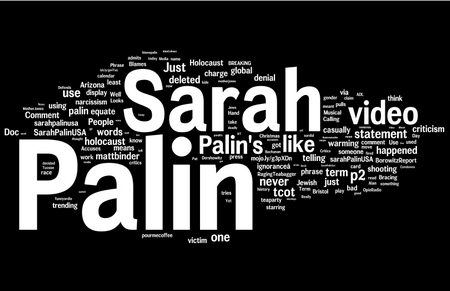 |
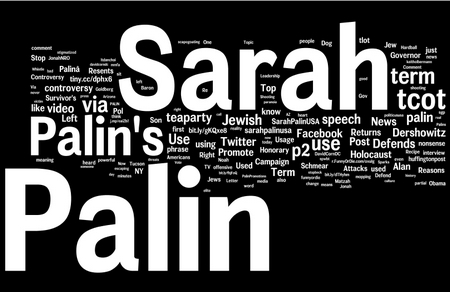 |
Palin and . . . on January 12 |
Palin and . . . on January 13 |
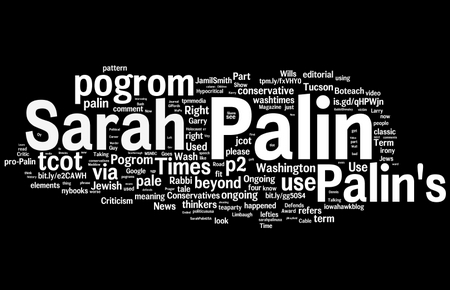 |
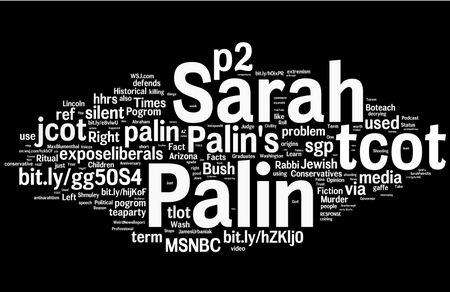 |
Palin and . . . on January 14 |
Palin and . . . on January 15 |
In these four word clouds Sarah Palin stands alone as the dominant wording in the tweets. Video became a bit larger on the 12th. Tcot emerges on the 13th rather than the 14th. Pogrom stands out even more on the 14th. And tcot reaches its apex on January 15. On the 15th exposeliberals is the 'name' of a twitter account that was very busy. And two urls show up for the first time.
When Sarah Palin is dropped out of the word clouds what were subsidiary themes in the language?
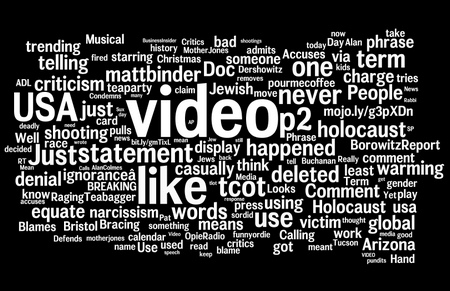 |
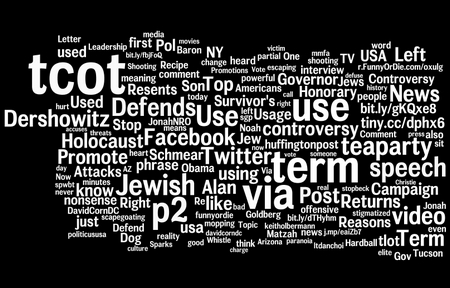 |
Other January 12 |
Other January 13 |
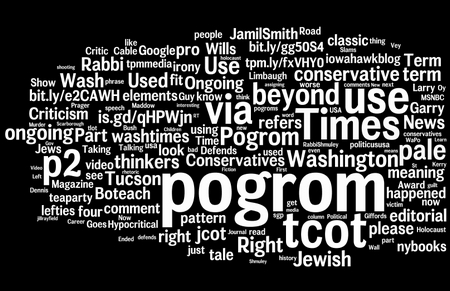 |
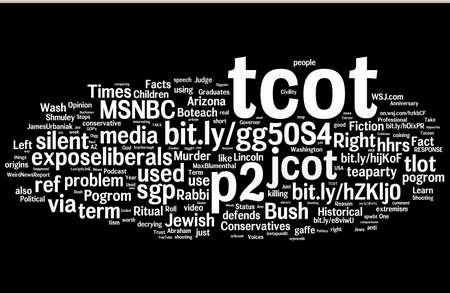 |
Other January 14 |
Other January 15 |
The pattern across the four days that is most clear is increasing politicization. #tcot and #p2 are two of the major 'signs' of conservatives and progressives. They go from barely standing out on the 12th to being the dominant figures by the 15th. Pogrom, which is only a major figure on the 14th, is part of the politicization as is the appearance of #jcot, which is Jewish conservative on Twitter. The 15th is dominated by symbols of political argument: tcot, p2, jcot, exposeliberals, MSNBC was pummeled for its interpretation of events, right, tlot, sgp, which is a conservative women's organization, and even Bush.
One of the most telling symbols of the increasing politicization is two urls: http://bit.ly/gg50S4 and http://bit.ly hZKlj0 that become major figures on the 15th. The two external files were referred to over and over. They are:
The first was a blog post on a blog STOP THE LEFTIST PROPAGANDA MACHINE. The second a video one hour and twenty minutes long, that had been viewed only 305 times when I checked the next day. It was repeatedly referred to as historical facts about "blood libel." It was a resurection of the original myth -- now on YouTube. The emergence of these two urls indicates how much the communication had leaned to defense of Palin.
The other character of these word clouds is the variety of expression. Only the political identifiers are important subsidiary themes. Otherwise the language is high variety -- it is all over the place. Once past blood libel, Sarah Palin, and the symbols of partisanship you find variety. In part, the variety can be understood by what we know -- there are many ways to say the same thing. So words are not necessarily a good indication of the communication. But an important reminder from this analysis is that human communication is multi-faceted. It does not easily reduce to: agree strongly, agree, disagree, and disagree strongly. So here are ten phrases to point to the variety.
Of course, you can do the reduction. See The Washington Post's version of questions with yes or no answers (Post).
What is to be learned from this analysis?
First, there is the point I made in an earlier analysis (Boynton, 2010). Move over old media you no longer have monopoly control of the public domain. If you look at the total context of twitter messages about the shooting of Representative Giffords you find hundreds of thousands, and it continues as Giffords recovers and Palin provides another self justification. If you have something to say you can say it. That is unlike any communcation environment since we all lived in villages. "Blood libel" was one small bit of that stream of messages, but it illustrates the interaction between Twitter messages and the 'old media' of newspapers, TV, and blogs -- even blogs are old by the standard of Twitter. Http is a dominant symbol all four days examined. Whether it is MSNBC or the blog STOP THE LEFTIST PROPAGANDA MACHINE the people communicating with Twitter are calling attention to what is there, arguing with the interpretations they dislike and affirming the ones they do like, and making fun. In addition to interaction with old media it is also interaction with other people communicating with Twitter; that is what RT tells us. It is a public communication environment that engages millions of people in political action.
Second, there is the variety in the communication. "Blood libel" gives only a small indication of the diversity. To collect messages about this episode of our history I searched for: Giffords, Palin, terrorism, #p2, #teaparty, blood libel, 9/11 because many Twitter messages put this in the context of 9/11, RT @barackobama, and #blamepalin. And each of those streams is high variety. The variety evident in the word clouds for blood libel is multiplied many times in this total collection.
Third, we learn something. As one person put it -- none of my gentile friends knew anything about blood libel. Now they do.The arguments about how to interpret the phrase and the appropriate circumstances in which to use it were many. We will probably all forget this soon enough, but it has become a part of American culture in a way that it never was before.
Finally, I want general patterns, too. But I do not want the general patterns of yes or no that The Post was happy with. And I do not want the generalities of blood libel, Palin, RT and http. That means I am going to have to become much more sophisticated in noticing patterns in the high variety. It is the challenge of taking communication seriously.
I end with a very irreverent tweet: Szng, Think I'll invent a drink. Name it "the blood libel" It'll be made of gin and stupid. Maybe I'll throw in a few moose tears.